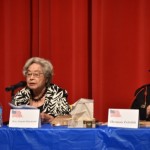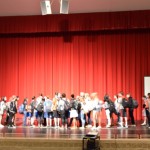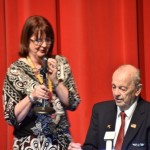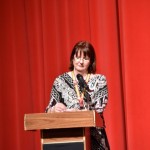My Air Force Days by Malcolm Lawrence Sr.
- Mr. Malcolm Lawrence Sr Ms. Welton, Mr. Herman Zeitchik
- Malcolm Lawrence Sr.
- Ms. Welton, Mary Tamaki Murakami
- Mary Tamaki Murakami, Mr Herman Zeitchik
- Students at Bethesda Chevy Chase High School
- Mr. Malcolm Lawrence Sr. Herman Zeitchik
- Ms. Welton, Malcolm Lawrence Sr.
- Mr. Malcolm Lawrence Sr.
- Ms. Welton Bethesda Chevy Chase High School teacher
My Air Force Days
by
Malcolm Lawrence Sr.
Seventy-one years ago, at age 18, I was inducted into the U.S. Army. The date was October 25, 1943. At Fort Meade, Maryland, I passed the exams for both Officers’ Candidate School and Air Cadet Training and chose the latter. I was sent to Miami Beach, Florida for basic training with high hopes of becoming a B-17 bomber pilot.
During my time there, one Saturday evening, I attended a dance at the First Street pier, where the Air Force band was playing. It was a terrific group with four trumpets, four trombones, five saxes and a four-piece rhythm section. Early in the evening, the bandleader announced that the drummer had become ill and asked if there was anyone there who could take his place. I came forward and sat in on the drums. That band blasted away on the swing tunes so loud I could hardly hear my drumming. That is always seventh heaven for a drummer.
I played with the band for two more weekends. The leader asked me to stay on as drummer and become a permanent party member of the band. Having been a big band drummer for two years before entering the service, I just loved playing drums, but I turned his offer down because I did not want to shift out of the Air Cadet training program.
I learned shortly thereafter that our class of five hundred was “washed out” because the Air Force already had too many pilots, navigators, and bombardiers. We were asked to express our second choice, and I chose to be a radio operator/gunner on the B-17.
On February 16, 1944, I was sent to Air Force radio school at Sioux Falls, South Dakota for six months of taking radio receivers and transmitters apart, putting them back together again, and learning to send and receive Morse code.
While at Sioux Falls, we were told that the losses of B-17s in Europe were running very high and that our chances of surviving were fifty percent.
On to gunnery school in Yuma, Arizona on July 27, 1944, where I first rode on a B-17 for aerial target practice with caliber 50 machine guns.
Our crew first met on October 5, 1944 at Tampa, Florida and we proceeded to Gulf Port, Mississippi, for 176 hours of flight training.
Our crew came from all over the country. The pilot, Noel Cheatam, hailed from Alabama. Co-pilot James Benson, came from Chicago, as did the waist gunner, Randall Bennett. The navigator, James Shipman, and I were from Washington, D.C. The tail gunner, Bill Edmisson was from Montana. The ball turret gunner, Max Gianelloni, came from Louisiana. The engineer gunner, James Elliott, was from New York, and the toggleer — the one who dropped the bombs, Howard Wallace hailed from California. Despite the geographical differences, we blended together as a great team. We all loved the B-17 and looked forward to the mission ahead of us.
We flew out of Goose Bay, Labrador and arrived at the 94th Bomb Group in Bury St. Edmunds, England on February 14, 1945. We flew 23 missions over Germany and France during the months of March and April.
The interesting thing about our crew was that no one spoke of fear or displeasure. We all trusted that plane and thought that it would bring us through.
My radio training really came in handy on one of our missions. After dropping our bombs over Germany, we were headed back to base when storm conditions and darkness threw us off course. The pilot was flying blind for almost an hour. The navigator reckoned that we were out somewhere over the North Sea, but he could not determine our position. The crew was tense.
I sent messages in Morse code to three radio stations. The responses told me where our plane was. Where the three lines intersected gave me the geographic location of our plane. I passed the coordinates on to the pilot, who set the course for home. We made it back safely with very little fuel to spare.
The most vivid memory of my tour of duty is a brief, but poignant, incident that occurred at midday on March 18, 1945. Our plane was approaching the target over Berlin. About that mission the Air Force Album (published in October 2009) wrote the following:
“March 18. 1945: Some 1,250 U.S. bombers, escorted by 670 fighters, deal Berlin its heaviest daylight blow – 3,000 tons of bombs on transportation and industrial areas.”
During bomb runs, it was my job as radio operator to release, on instruction from the co-pilot, packages of tin foil strips known as “chaff” through a chute behind the radio operator’s swivel seat. This operation was to confuse the sights of the radar-controlled anti-aircraft guns by creating a blur instead of a precise target; it made one plane look like three.
On the March 18 Berlin bomb run, 500 batteries of German guns were filling the air with exploding flak. The co-pilot said on intercom: “Co-pilot to Radio, start tossing chaff.” Just as I turned to release the tin foil, a piece of flak tore a 3-inch hole through the left side of the plane, chest-high, at the very spot where I had been sitting one second earlier.
That was quite a scare for a 19-year old. Such a shot in my side would have ripped me asunder. I thanked the co-pilot for his timely command.
During our 23 missions, we flew through all kinds of flak and were challenged by German jets. We lost engines, had two forced landings and experienced other dangers, but that piece of flak on mission no. 8 over Berlin had my name on it. I thank God that I am able to write about it.
At the 94th Bomb Group base, a typical day started early. The gentle awakening at 3:15 AM was followed by a dash to the latrine along with sixty other airmen to wash hands and face, after which a mad run ensued for the mess hall on bicycle over a winding dirt path through one mile of woods in pitch darkness. (As one couldn’t use lights, one had to learn this path by heart.) Next, a hearty breakfast of fried eggs and coffee took place (on non-mission days, we had powdered eggs, which provided our greatest incentive for flying even dangerous missions). At 4:10 AM a briefing on the mission took place, and takeoff at 5:50 AM led to a six-to ten-hour mission, depending on the target location. Then we would return to base, unload, clean guns, and proceed to interrogation, where each crew member was given a double shot of cognac (two of our crew didn’t drink, so a couple of others had quadruple shots-ugh). From there, we went back to the hut to wash up and try before dark (for obvious reasons) to cycle up to and back from the mess hall. Sometime between 6:00 and 7:00 PM, we returned to the hut to rest our weary heads. Then a caller stuck his head in the door and announced that tomorrow would be another beautiful day, and a 3:00 AM flight call was in order. In our exhausted state, the prospect of having to do anything was truly demoralizing. On the other hand, when our little announcer indicated bad weather for two days, all of us leaped from bed to apply for passes to London. Actually, I went to London eleven times in six month, but didn’t see much because of the fog and blackout conditions, despite which I still managed to acquire a “feel” for the city.
The nice thing about flying combat missions was that life was fairly normal between flights. We were exposed only while flying over enemy territory. Consequently, after a tour of missions, our crew certainly was not shell-shocked and, in fact, felt pretty good about life in general.
We were told, however, that we had been under a tremendous strain, and so it was that in late April 1945 we were sent to a “rest home,” a beautiful English villa, for 10 days.
While our crew was there, the war virtually ended in Europe. I was in London on V-E Day, May 8, 1945, watching the movie “The Picture of Dorian Gray.” In the middle of the film, an announcement on the public-address system proclaimed that the war in Europe was officially over. Hundreds of us rushed out of the theatre into Piccadilly Circus and witnessed the wild celebration.
Thousands of people had filled the area, and some eager beavers were even climbing up the statue of Eros, the Greek god of love. That was a most appropriate spot, because girls, young and old, were chasing, hugging, and kissing every military man on the scene. It was a miracle that I managed to escape — after about an hour.
For a number of reasons, it took from May to November to redeploy us to the United States. Perhaps the most significant explanation was that our navigator fell ill. We lost the plane to another crew and were unable to fly home. For redeployment purposes, we had to compete with members of the infantry, and other ground forces from the Continent, who had anywhere from 100 to 200 “points.” Being relatively short-term flyboys, we had fewer, around 70 to 80 of the go-home credits, so we had to sweat it out.
For most of the period, we stayed at a “reple-deple” replacement depot at Chorley, where living took on the truest form of democracy. That is, we had to wait on each other. Combat-hardened tech sergeants and master sergeants found themselves lining up every morning and taking orders from a “permanent party” corporal who proudly wore ribbons for the American and European theatres of operation, the Good Conduct Medal and a sharpshooter award.
After a succession of crummy daily jobs, I – though only a lowly staff sergeant – was assigned as a semi- permanent “block chief,” a title that gave me the privilege of performing the full range of duties as a barracks janitor. I pulled an inspection twice a week and took great pleasure in telling the two master sergeants in my charge that unless they kept their bunk areas neater, I would report them to the corporal.
Things got so bad during that period, I even took to writing poetry:
THE FORLORN SOLDIER
Here I sit overseas.
All I ask is one boat please.
And let me stow away upon it,
Lest I have a royal fit.
I miss my girl, I miss my home,
I miss a chocolate ice cream cone.
Though home and cone do not rhyme,
I’ll consider that some other time.
I long to ride in automobiles
And wear heel-plates on my heels.
But most of all I’d like to scrutinize
My gal-friends rootin’-tootin’ eyes.
Here’s hoping that my wish comes true
And that it doesn’t go askew.
My unhappiness would surely end
If some kind soul would condescend
And kinda send
ME HOME.
At long last, I sailed home on the SS Europa, a former German luxury liner converted to a troop ship. This trip it “accommodated” some nine thousand GIs. The bunks were piled six high everywhere. I slept on the fifth tier in the dining room and fell out only once. The principal activity on the cruise was eating; we waited in chow lines a full seven hours out of our waking day. After docking in New York and spending a week in Brooklyn, we were sent by rail to Fort Meade, Maryland. On my final day in the Air Force, I and a large number of other overly-anxious youths were asked to turn in all of our GI issue clothing, except for one full uniform to wear home. I threw one tan sock and a dirty, torn T-shirt onto the conveyor belt, picked up my B-4 bag, and ran out into the free, fresh-smelling postwar world.
Some interesting facts: Altogether there were 159 airfields in the United Kingdom, of which 62 were for heavy bombers (B-17s and B-24s). During the war 6,500 B-17s were assigned to the 8th Air Force. Of these, 1,301 (20%) were lost in action. There were 3,800 B-24s; 1,135 (30%) were lost in action.
In our time, the B-17G had a nine-man crew. There were 12 caliber 50 machine guns onboard to shoot at enemy planes. Each gun was supplied with 500 rounds fed through the gun on a conveyor belt. The range of the B-17 was 2,000 miles. The normal bomb load was 2 tons. The bomb weights we carried varied (100 lbs., 300 lbs., 500 lbs., 1000 lbs., and occasionally two 2,000 pounders). The speed of our plane ranged from 180-215 mph at 25,000 feet. The maximum speed was 287 mph, but we never went that fast. The radio room was in the middle of the plane, just behind the bomb bay.
Between August 1944 and July 1945, I spent 521 hours in the B-17. To my mind, it was the best bomber ever made. I will forever cherish the memory of flying in that plane and participating in the American effort during World War II.
Presented twice on April 30, 2015 at the Bethesda-Chevy Chase High School auditorium, Bethesda, Maryland before 500 Ninth graders.



















